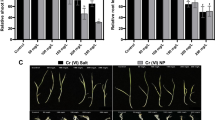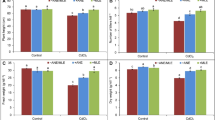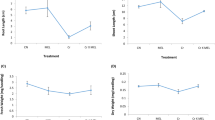Abstract
In India, rice is the principal crop and is the staple diet of majority of the population. Widespread use of hexavalent chromium [Cr(VI)] in leather processing, wood preservatives, stainless-steel manufacture, and electroplating industries has resulted in contamination of paddy fields and poses a great challenge to the society be it crops, animals, or human beings. Cr(VI) toxicity results in growth inhibition and leading to changes in components of antioxidant systems as well as secondary metabolites. We evaluated the comparative short and long term effects of Cr(VI) stress on rice plants to explore the plant defense responses against Cr stress. Different assays including the phenolic and flavonoid content evaluation, malondialdehyde (MDA), proline, antioxidant enzyme analysis, and DPPH assay were performed to understand the plant response against the Cr(VI) stress. Total phenols and flavonoids were significantly higher in Cr stressed plants as compared to control groups. Under Cr(VI) exposure, significant higher accumulation of proline was observed. Similarly, high levels of MDA content were also observed after 7 days of Cr stress. In addition, the antioxidant activities such as GST, APX, and SOD including DPPH radical scavenging were also markedly increased during Cr(VI) stress. Further identification and quantification of phenols were done spectrophotometrically to view the whole spectrum of phenolics. HPLC analysis showed gallic acid as the main contributor to abiotic defense response. Our study showed that Cr stress imposes serious toxic effects and plant phenolics have a protective role against metal stress.








Similar content being viewed by others
References
Anjum NA, Gill SS, Gill R (2014) Metal/metalloid stress tolerance in plants: role of ascorbate, its redox couple, and associated enzymes. Protoplasma 251(6):1265–1283
Asada K (1992) Ascorbate peroxidase–a hydrogen peroxide-scavenging enzyme in plants. Physiol Plant 85(2):235–241
Baker CJ, Mock NM (1994) An improved method for monitoring cell death in a cell suspension and leaf disk assays using Evans blue. Plant Cell Tissue Organ Cult 39:7–12
Balasundram N, Sundram K, Samman S (2006) Phenolic compounds in plants and agri-industrial by-products: antioxidant activity, occurrence, and potential uses. Food Chem 99:191–203
Bates LS, Waldren RP, Teare ID (1973) Rapid determination of free proline for water-stress studies. Plant Soil 39(1):205–207
Braca A, Sortino C, Politi M, Morelli I, Mendez J (2002) Antioxidant activity of flavonoids from Licania licaniaeflora. J Ethnopharmacol 79:379–381
Bradford MM (1976) A rapid and sensitive method for the quantitation of microgram quantities of protein utilizing the principle of protein-dye binding. Anal Biochem 7(72):248–254
Britto AJD, Roshan Sebastian S, Sheeba Gracelin DH (2013) Effect of lead on malondialdehyde, superoxide dismutase, proline activity and chlorophyll content in Capsicum annum. Biores Bull 5:357–362
Chen YA, Chi WC, Huang TL, Lin CY, Nguyeh TT, Hsiung YC, Chia LC, Huang HJ (2012) Mercury-induced biochemical and proteomic changes in rice roots. Plant Physiol Biochem 55:23–32
DalCorso G, Fasani E, Furini A (2013) Recent advances in the analysis of metal hyperaccumulation and hypertolerance in plants using proteomics. Front Plant Sci 4:280
Dubey S, Misra P, Dwivedi S, Chatterjee S, Bag SK, Mantri S, Asif MH, Rai A, Kumar S, Shri M, Tripathi P, Tripathi RD, Trivedi PK, Chakrabarty D, Tuli R (2010) Transcriptomic and metabolomic shifts in rice roots in response to Cr (VI) stress. BMC Genomics 11:648
Dubey S, Shri M, Misra P, Lakhwani D, Bag SK, Asif MH, Trivedi PK, Tripathi RD, Chakrabarty D (2014) Heavy metals induce oxidative stress and genome-wide modulation in transcriptome of rice root. Funct Integr Genomics 14:401–417
Emamverdian A, Ding Y, Mokhberdoran F, Xie Y (2015) Heavy metal stress and some mechanisms of plant defense response. Sci World J 2015:1–18
García-Sánchez M, Garrido I, de Jesús Casimiro I, Casero PJ, Espinosa F, García-Romera I, Aranda E (2012) Defence response of tomato seedlings to oxidative stress induced by phenolic compounds from dry olive mill residue. Chemosphere 89(6):708–716
Gharibi S, Tabatabaei BE, Saeidi G, Goli SA (2016) Effect of drought stress on total phenolic, lipid peroxidation, and antioxidant activity of Achillea species. Appl Biochem Biotechnol 178(4):796–809
Gomez KA, Gomez KA, Gomez AA (1984) Statistical procedures for agricultural research. John Wiley & Sons, Hoboken
Habig WH, Pabst MJ, Jakoby WB (1974) Glutathione S-transferases: the first enzymatic step in mercapturic acid formation. J Biol Chem 249(22):7130–7139
Hayat S, Hayat Q, Alyemeni MN, Wani AS, Pichtel J, Ahmad A (2012) Role of proline under changing environments: a review. Plant Signal Behav 7(11):1456–1466
Heath RL, Packer L (1968) Photoperoxidation in isolated chloroplasts. I. Kinetics and stoichiometry of fatty acid peroxidation. Arch Biochem Biophys 125(1):189–198
Hossain Z, Komatsu S (2013) Contribution of proteomic studies towards understanding plant heavy metal stress response. Front Plant Sci 3:310
Hossain MA, Shah MD, Gnanaraj C, Iqbal M (2011) In vitro total phenolics, flavonoids contents and antioxidant activity of essential oil, various organic extracts from the leaves of tropical medicinal plant Tetrastigma from Sabah. Asian Pac J Trop Med 4(9):717–721
Hossain MA, Piyatida P, da Silva JAT, Fujita M (2012) Molecular mechanism of heavy metal toxicity and tolerance in plants: central role of glutathione in detoxification of reactive oxygen species and methylglyoxal and in heavy metal chelation. J Bot 2012:1–37
Hua Y, Clark S, Ren J, Sreejayan N (2012) Molecular mechanisms of chromium in alleviating insulin resistance. J Nutr Biochem 23(4):313–319
Irfan M, Ahmad A, Hayat S (2014) Effect of cadmium on the growth and antioxidant enzymes in two varieties of Brassica juncea. Saudi J Biol Sci 21(2):125–131
Keilig K, Ludwig-Muller J (2009) Effect of flavonoids on heavy metal tolerance in Arabidopsis thaliana seedlings. Bot Stud 50:311–318
Kisa D, Elmastaş M, Öztürk L, Kayır Ö (2016) Responses of the phenolic compounds of Zea mays under heavy metal stress. Appl Biol Chem 59(6):813–820
Korkina LG (2007) Phenylpropanoids as naturally occurring antioxidants: from plant defense to human health. Cell Mol Biol 53(1):15–25
Lopez A, Rico M, Santana-Casiano JM, González AG, González-Dávila M (2015) Phenolic profile of Dunaliella tertiolecta growing under high levels of copper and iron. Environ Sci Pollut Res Int 22(19):14820–14828
Mahdi-Pour B, Jothy SL, Latha LY, Chen Y, Sasidharan S (2012) Antioxidant activity of methanol extracts of different parts of Lantana camara. Asian Pac J Trop Biomed 2(12):960–965
Maleki M, Ghorbanpour M, Kariman K (2017) Physiological and antioxidative responses of medicinal plants exposed to heavy metals stress. Plant Gene 11:247–254
Mandal BK, Vankayala R, Uday Kumar L (2011) Speciation of chromium in soil and sludge in the surrounding tannery region, Ranipet, Tamil Nadu. ISRN Toxicology 2011:697980
Michalak A (2006) Phenolic compounds and their antioxidant activity in plants growing under heavy metal stress. Pol J Environ Stud 15(4):523–530
Nancharaiah YV, Dodge C, Venugopalan VP, Narasimhan SV, Francis AJ (2010) Immobilization of Cr (VI) and its reduction to Cr (III) phosphate by granular biofilms comprising a mixture of microbes. Appl Environ Microbiol 76(8):2433–2438
Panda SK, Choudhury S (2005) Chromium stress in plants. Braz J Plant Physiol 17:95–102
Panda SK, Chaudhury I, Khan MH (2003) Heavy metals induce lipid peroxidation and affect antioxidants in wheat leaves. Biol Plant 46(2):289–294
Pandey S, Fartyal D, Agarwal A, Shukla T, James D, Kaul T, Negi YK, Arora S, Reddy MK (2017) Abiotic stress tolerance in plants: myriad roles of ascorbate peroxidase. Front Plant Sci 8:581
Parvaiz A, Satyawati S (2008) Salt stress and phyto-biochemical responses of plants—a review. Plant Soil Environ 54:88–99
Pinelo M, Rubilar M, Sineiro J, Nunez MJ (2004) Extraction of antioxidant phenolics from almond hulls (Prunus amygdalus) and pine sawdust (Pinus pinaster). Food Chem 85:267–273
Quan NT, Anh LH, Khang DT, Tuyen PT, Toan NP, Minh TN, Bach DT, Ha PT, Elzaawely AA, Khanh TD, Trung KH (2016) Involvement of secondary metabolites in response to drought stress of rice (Oryza sativa L.). Agriculture 6(2):23
Ramakrishna A, Ravishankar GA (2011) Influence of abiotic stress signals on secondary metabolites in plants. Plant Signal Behav 6(11):1720–1731
Rao A, Ahmad SD, Sabir SM, Awan SI, Hameed A, Abbas SR, Shehzad M, Khan MF, Shafique S, Ahmad Z (2013) Detection of saline tolerant wheat cultivars (triticum aestivum l.) using lipid peroxidation, antioxidant defense system, glycine-betaine and proline contents. J Anim Plant Sci 23:1742–1748
Sampaio BL, Edrada-Ebel R, Da Costa FB (2016) Effect of the environment on the secondary metabolic profile of Tithonia diversifolia: a model for environmental metabolomics of plants. Sci Rep 6:29265
Sharma P, Jha AB, Dubey RS, Pessarakli M (2012) Reactive oxygen species, oxidative damage, and antioxidative defense mechanism in plants under stressful conditions. J Bot 2012:1–26. Plant Biotechnol 32:243–247
Shen M, Zhao DK, Qiao Q, Liu L, Wang JL, Cao GH, Li T, Zhao ZW (2015) Identification of glutathione S-transferase (GST) genes from a dark septate endophytic fungus (Exophiala pisciphila) and their expression patterns under varied metals stress. PLoS One 10(4):e0123418
Shri M, Kumar S, Chakrabarty D, Trivedi PK, Mallick S, Misra P, Shukla D, Mishra S, Srivastava S, Tripathi RD, Tuli R (2009) Effect of arsenic on growth, oxidative stress, and antioxidant system in rice seedlings. Ecotoxicol Environ Saf 72(4):1102–1110
Sytar O, Hemmerich I, Zivcak M, Rauh C, Brestic M (2016) Comparative analysis of bioactive phenolic compounds composition from 26 medicinal plants. Saudi J Biol Sci
Tsao R (2010) Chemistry and biochemistry of dietary polyphenols. Nutrients 2(12):1231–1246
Wojdylo A, Oszmianski J, Czemerys R (2007) Antioxidant activity and phenolic compounds in 32 selected herbs. Food Chen 105:940–949
You J, Chan Z (2015) ROS regulation during abiotic stress responses in crop plants. Front Plant Sci 6:1092
Zhang T, Lu Q, Su C, Yang Y, Hu D, Xu Q (2017) Mercury induced oxidative stress, DNA damage, and activation of antioxidative system and Hsp70 induction in duckweed (Lemna minor). Ecotoxicol Environ Saf 143:46–56
Acknowledgments
The authors acknowledge the Jaypee Institute of Information Technology, Noida for providing facilities and support during the study.
Funding
The study receives financial assistance from the SERB project File No. YSS/2015/000742.
Author information
Authors and Affiliations
Corresponding author
Additional information
Responsible editor: Philippe Garrigues
Rights and permissions
About this article
Cite this article
Dubey, S., Gupta, A., Khare, A. et al. Long- and short-term protective responses of rice seedling to combat Cr(VI) toxicity. Environ Sci Pollut Res 25, 36163–36172 (2018). https://doi.org/10.1007/s11356-018-3422-z
Received:
Accepted:
Published:
Issue Date:
DOI: https://doi.org/10.1007/s11356-018-3422-z




